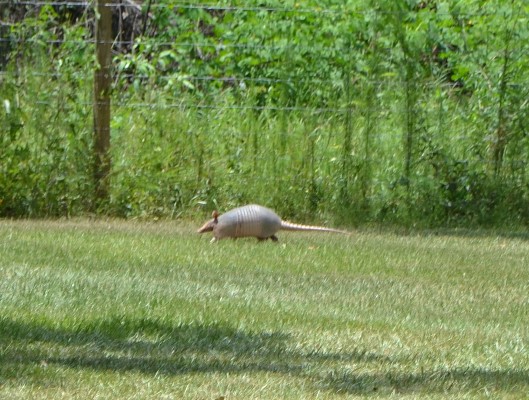
by Les Harrison | Mar 9, 2018
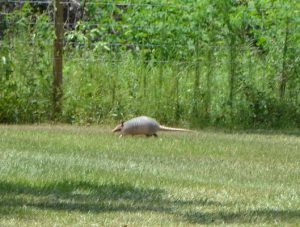
The common nine banded armadillo scurrying across the lawn.
Photo: Les Harrison
The first light of morning can reveal random pockmarks in what had been the perfect lawn the previous evening. The culprit is not likely the neighborhood teenager with a reputation for inappropriate practical jokes.
The offender usually is the nine-banded armadillo, sometimes referred to as a Florida-speed-bump or Possum-on-the-half-shell. In addition to manicured landscapes, they also encroach in natural areas and destroy sensitive habitats.
Armadillos eat adult insects and larvae, but also quail and turtle eggs. They incessantly dig holes in their search for food, many times uprooting plants in their food search. Their foraging holes are approximately one to three inches deep and three to five inches wide.
Using insecticides in landscapes to decrease the armadillo food supply is not guaranteed, but may help reduce the digging. In cases where there is a large, and always ravenous, armadillo population this reduction of food may increase digging activity as they search more diligently for a smaller food supply.
Another consideration is all chemical treatments have to be reapplied on a permanent basis for long term control. Always read and follow label instructions for safe use of insecticides.
Armadillos rest in a deep burrow during the day and are usually active after dark. Burrows openings are approximately seven to eight inches in diameter, about the size of a one-gallon plastic jug, and up to 15 feet in length.
This exotic invasive may burrow under driveways, foundations and patios potentially causing structural damage. Additionally, their burrows in pastures pose a potential leg-injury hazard to large wildlife and livestock.
Several live-trapping techniques can be used to capture armadillos as they exit of their burrows. Because armadillos are nocturnal, trapping techniques designed to capture them as they emerge from their burrows should be applied late in the afternoon and checked several hours after darkness.
Fencing is another option to discourage the presence of armadillos. Relocating captured animals is illegal and not recommended because it only transfers the problem elsewhere and can spread this problem species.
Fossil records indicate the armadillo’s ancestors were as large as modern-day rhinos. One can only imagine what front yards would look like if they still existed.
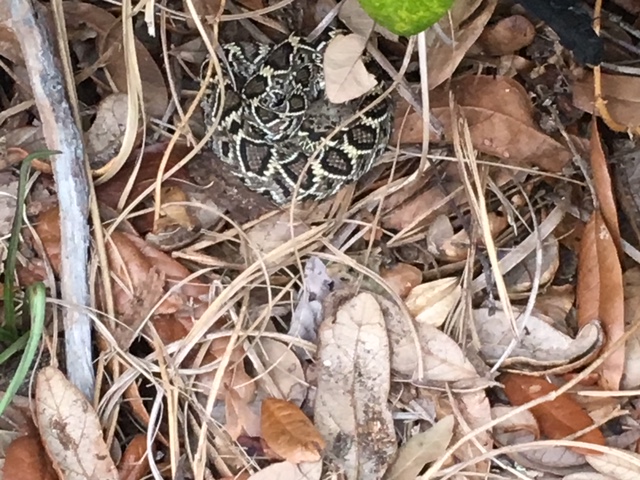
by Rick O'Connor | Mar 9, 2018
Most people know that snakes are ectothermic and the environment is what regulates their body temperature. However, many do not know that they like to maintain their temperature close to 98 F like us. To do this they must move to locations where they can either warm (like basking in the sun or lying on warm asphalt) or cool (like under rocks or logs). Unlike us, their temperature can rise to above 100 F or down close to 30 F with few health problems.
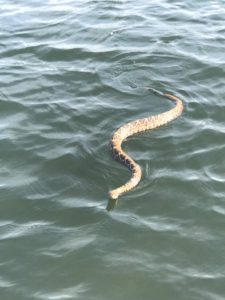
Eastern Diamondback Rattlesnake swimming across the Intracoastal Waterway near Pensacola Beach.
Photo: Andy Barnes
When environmental temperatures become colder, their heart and breathing rates slow significantly. Their blood oxygen levels decrease, and they become very slow and sluggish – a condition we call torpor. There are some advantages to this, such as not having to hunt for food for several weeks or months, but when the air temperatures begin to climb they become more active… Moreover, their hungry.
In the last two weeks, I have had numerous reports of snakes moving around in yards. There have been three records of diamondback rattlesnakes in the Pensacola Beach area alone.
Should I be concerned about doing outdoor activities?
No, not really – but you should be aware. As it warms, snakes will become more active early in the morning and late in the evening. Pit vipers, like rattlesnakes and cottonmouths, actually prefer hunting at night. However, when the temperatures are cool enough for mid-day movement, they will. Food and reproduction (for some species) are on their mind this time of year.
Stay on the trails – snakes typically do not like to be in the open because of predators but they do have to bask to increase their body metabolism; so they may be along the edge. If I am hiking, I tend to look down along the trail when walking. If I want to observe something in the trees, I stop.
These snake movements happen every year, and very people have problems, but with the recent increase in encounters it is could to be aware. I actually think snakes are pretty cool. I enjoy seeing them, especially ones that are not viewed very often like coral snakes and rattlesnakes. You should still go out and enjoy the Pensacola Bay area. It is a great time of year to do it.
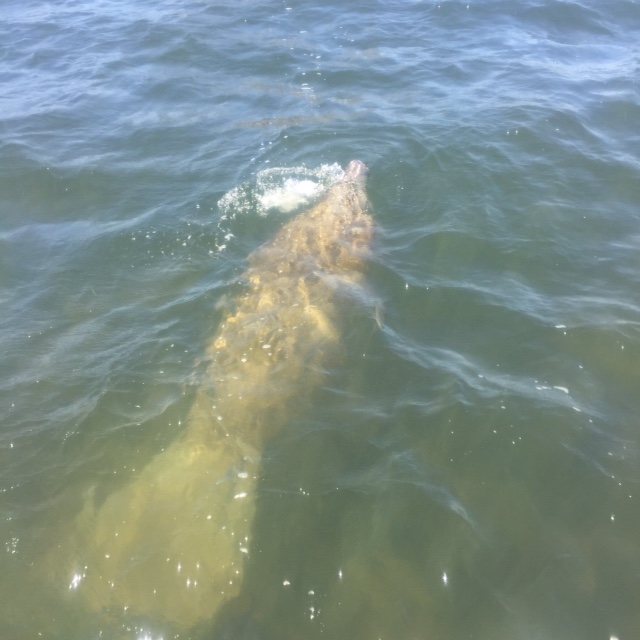
by Rick O'Connor | Feb 16, 2018
As a young boy growing up here in the panhandle, I had heard of this thing called a manatee – but had never seen one. They came more into the light when I was a teenager and becoming interested in marine biology. I was the president of the high school marine biology club and one of our goals was to raise money for a trip to Crystal River to snorkel with them. The Save the Manatee Club originated in that time trying to bring more awareness to the plight of this endangered Floridian and at one point, Jimmy Buffett had led the way.
I had learned a lot about them, found out their original range was from North Carolina south to the Caribbean and the entire Gulf of Mexico, but were now down to about 1000 animals and those were found in Florida. Eventually I did get to see manatees, and have snorkeled with them many times, but still thought of them as a south Florida animal – rarely found in the panhandle.
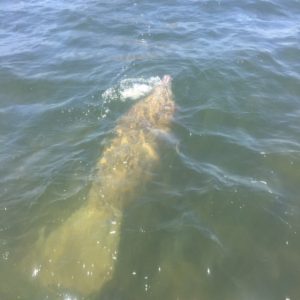
Manatee swimming in Big Lagoon near Pensacola.
Photo: Marsha Stanton
Then the recent news report – two dead manatees in the last two weeks. One washed ashore in Okaloosa county and the other in Escambia. Probably victims of the recent cold fronts. It is not unheard of finding manatees in the panhandle in recent years. I recall since the 1990’s a manatee seen in Bayou Texar in Pensacola. In another year, one was seen near Ft. Pickens. My son worked at a local marina and saw at least one a year there. There have been so many seen in the Mobile Bay area that Dauphin Island Sea Lab now has a Manatee Watch program. There are about 40 individuals that now visit Wakulla Springs. In addition, this summer there were two separate groups living in the Pensacola area. One group was residing near Gulf Breeze and a second group of about eight animals was frequently seen near Perdido Key. These once rare animals in the panhandle are now being found each year, and sometimes in groups.
What is going on?
Why are manatees beginning to visit our area?
Your first hunch would be climate change. Manatees are marine mammals but unlike their dolphin cousins their blubber layer is not as thick and they must seek warm water refuge during the winter months. When water temperatures drop below 67°F, they locate the warm water springs found in central Florida – or move south Florida where the water remains comfortable year round. If they are remaining here, could the average water temperatures have warmed enough for them to make this move?
Along this same line, mangroves are now being found in the panhandle. Both red and black mangroves have been found growing in local estuaries. In the Apalachicola area there have been quite a few located. In the western panhandle there a few individuals here and there. Further west they are found on the islands of Mississippi and have been in the Chandeleurs for many years now. Later this spring Florida Sea Grant will be conducting surveys in each county to see where these tropical trees may be growing.
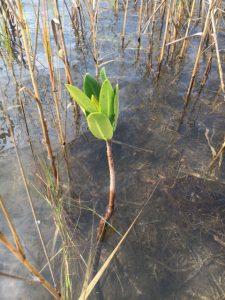
A small red mangrove growing in Big Lagoon near Pensacola FL
Photo: Rick O’Connor
And most recently are sightings of snook, a south Florida fish that have, though rare, been seen in the northern Gulf of Mexico. No doubt this Januarys hard freezes probably killed the mangroves that were here, and probably the two manatees washed ashore recently, but it will be an interesting time to see what other tropical species begin their slow migration northward. If it does happen, what will that mean? How will these changes impact local ecosystems? At this point, I am not sure if it will happen or, if it does, how fast – but it will be interesting.
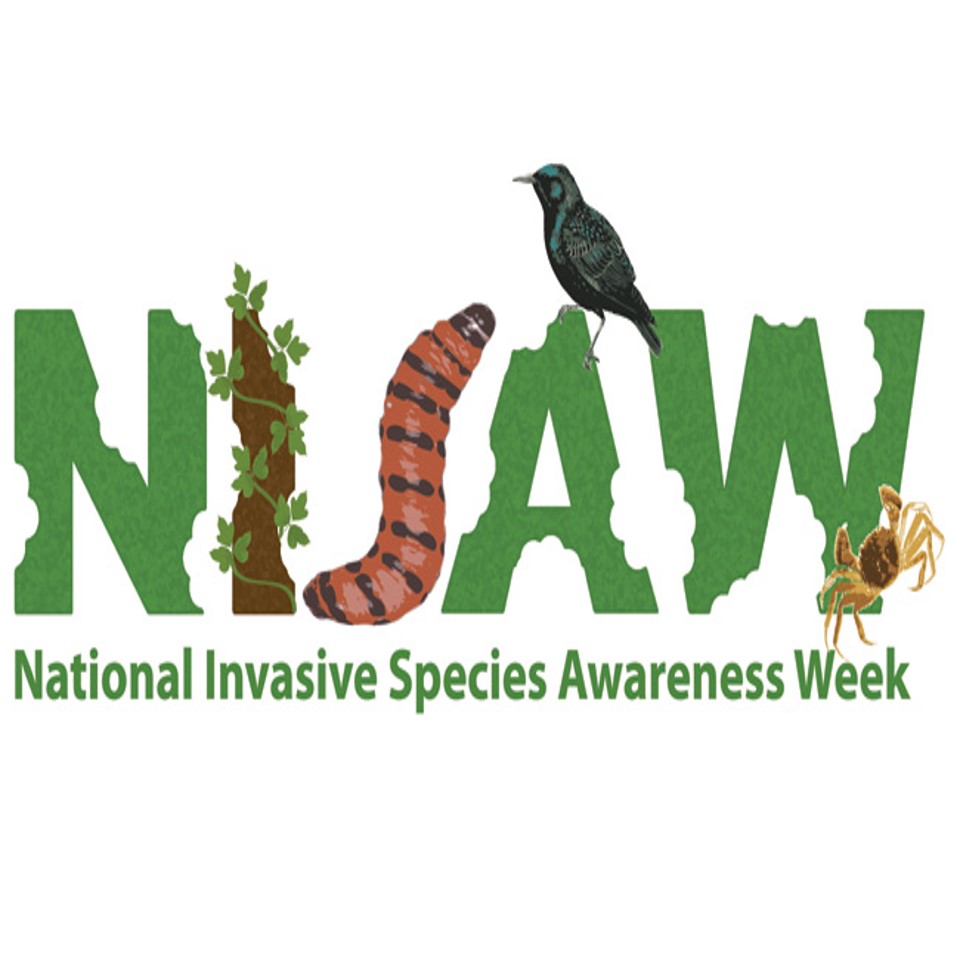
by Jennifer Bearden | Feb 2, 2018
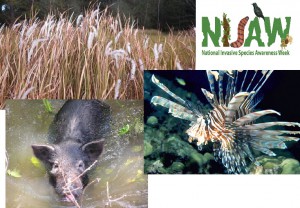 Aliens are invading our forests, pastures, fields and lawns. Well, okay, it’s not aliens but it is invasive species. Invasive species are non-native or exotic species that do not naturally occur in an area, cause economic or environmental harm, or negatively impact human health. These invasive species have become the number one threat to biodiversity on protected lands. However, invasive species do not know boundaries, and as a result, public, private lands, natural and man-made water bodies, and associated watersheds are affected. National Invasive Species Awareness Week (NISAW) is February 26-March 2, 2018.
Aliens are invading our forests, pastures, fields and lawns. Well, okay, it’s not aliens but it is invasive species. Invasive species are non-native or exotic species that do not naturally occur in an area, cause economic or environmental harm, or negatively impact human health. These invasive species have become the number one threat to biodiversity on protected lands. However, invasive species do not know boundaries, and as a result, public, private lands, natural and man-made water bodies, and associated watersheds are affected. National Invasive Species Awareness Week (NISAW) is February 26-March 2, 2018.
It is estimated that Florida Agriculture loses $179 million annually from invasive pests (http://www.defenders.org/sites/default/files/publications/florida.pdf). Generally, eradication of an invasive species is difficult and expensive. Most of the mitigation efforts focus on control rather than eradication.
EDDMaps (Early Detection and Distribution Mapping System), a web-based mapping system for reporting invasive species, currently has 667 different invasive plants reported in Florida. Many invasive insects, animals and diseases have also landed in Florida. Some famous invasive species in Florida include cogongrass, wild hogs, red imported fire ants, Chinese tallow, and lionfish.
For National Invasive Species Awareness Week, the University of Florida IFAS Northwest Extension District will highlight new invasive species each day. There are a couple of ways to receive this information during NISAW:
You can help us control invasive species in several ways:
- Always be cautious when bringing plants or plant materials into the state. Plants or even dead plant material can harbor weeds, insects and diseases that can become invasive in our state.
- When you see something suspicious, contact your local extension agent for help identifying the weed, insect or disease.
- You can volunteer your time and effort. Invasive species control is difficult and requires a cooperative effort for funding and manpower. The state has several Cooperative Invasive Species Management Areas (CISMA) in which public and private organizations work together to control invasive species in their area. These CISMAs hold work days in which volunteers can help remove invasive species from the environment. https://www.floridainvasives.org/cismas.cfm
For more information about NISAW or invasive species, contact your local county extension agent.

by Sheila Dunning | Jan 19, 2018
 The Florida Master Naturalist Program is an adult education University of Florida/IFAS Extension program. Training will benefit persons interested in learning more about Florida’s environment or wishing to increase their knowledge for use in education programs as volunteers, employees, ecotourism guides, and others.
The Florida Master Naturalist Program is an adult education University of Florida/IFAS Extension program. Training will benefit persons interested in learning more about Florida’s environment or wishing to increase their knowledge for use in education programs as volunteers, employees, ecotourism guides, and others.
Through classroom, field trip, and practical experience, each module provides instruction on the general ecology, habitats, vegetation types, wildlife, and conservation issues of Coastal, Freshwater and Upland systems. Additional special topics focus on Conservation Science, Environmental Interpretation, Habitat Evaluation, Wildlife Monitoring and Coastal Restoration. For more information go to: http://www.masternaturalist.ifas.ufl.edu/ Okaloosa and Walton Counties will be offering Upland Systems on Thursdays from February 15- March 22. Topics discussed include Hardwood Forests, Pinelands, Scrub, Dry Prairie, Rangelands and Urban Green Spaces. The program also addresses society’s role in uplands, develops naturalist interpretation skills, and discusses environmental ethics. Check the website for a Course Offering near you :http://conference.ifas.ufl.edu/fmnp/
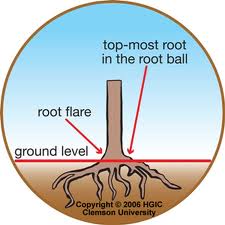
by Sheila Dunning | Jan 19, 2018
We plant trees with the intention of them being there long after we are gone. However, m any trees and shrubs fail before ever reaching maturity. Often this is due to improper installation and establishment. Research has shown that there are techniques to improve survivability. Before digging the hole:
any trees and shrubs fail before ever reaching maturity. Often this is due to improper installation and establishment. Research has shown that there are techniques to improve survivability. Before digging the hole:
- Look up. If there is a wire, security light, or building nearby that could interfere with proper development as it grows, plant elsewhere.
- Dig a shallow planting hole as wide as possible. Shallow is better than deep! Many people plant trees too deep. A hole about one-and-one-half the diameter of the width of the root ball is recommended. Wider holes should be used for compacted soil and wet sites. In most instances, the depth of the hole should be LESS than the height of the root ball, especially in compacted or wet soil. If the hole was inadvertently dug too deep, add soil and compact it firmly with your foot. .
- Find the point where the top-most root emerges from the trunk. If this is buried in the root ball then remove enough soil from the top so the point where the top-most root emerges from the trunk is at the surface. Burlap on top of the ball may have to be removed to locate the top root.
- Slide the plant carefully into the planting hole. To avoid damage when setting a large tree in the hole, lift the tree with straps or rope around the root ball, not by the trunk. Special strapping mechanisms need to be constructed to carefully lift trees out of large containers.
- Position the plant where the top-most root emerges from the trunk slightly above the landscape soil surface. It is better to plant a little high than to plant it too deep. Remove most of the soil and roots from on top of the root flare and any growing around the trunk or circling the root ball. Once the root flare is at the appropriate depth, pack soil around the root ball to stabilize it. Soil amendments are usually of no benefit. The soil removed from the hole and from on top of the root ball makes the best backfill unless the soil is terrible or contaminated. Insert a square-tipped balling shovel into the root ball tangent to the trunk to remove the entire outside periphery. This removes all circling and descending roots on the outside edge of the root ball.
- Straighten the plant in the hole. Before you begin backfilling have someone view the plant from two directions perpendicular to each other to confirm that it is straight. Break up compacted soil in a large area around the plant provides the newly emerging roots room to expand into loose soil. This will hasten root growth translating into quicker establishment Fill in with some more backfill soil to secure the plant in the upright position.
- Remove synthetic materials from around trunk and root ball. Synthetic burlap needs to be completely removed from the root ball; treated burlap can be left in place. String, strapping, plastic, and other materials that will not decompose and must be removed from the trunk at planting. Remove the wire above the soil surface from wire baskets before backfilling.
- Apply a 3-inch-layer of mulch. To retain moisture and suppress weeds cover the outer half of the root ball with an organic mulch. Do not cover the stem of the plant or the connecting root flare.
- Water consistently until established. For nursery stock less than 2-inches in caliper, this will require every other day for 2 months, followed by weekly 3-4 months. At each irrigation, apply 2 to 3 gallons of water per inch trunk caliper directly over the root ball. Never add irrigation if the ground is saturated.











